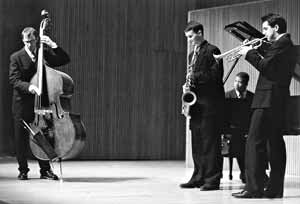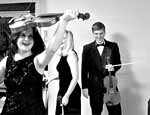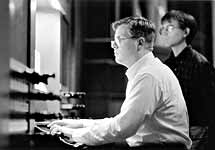Breaking News
Expanding
the Wall of the Concert Hall:
AT&T Labs Webcasts Begin
by Linda Shockley

ON A TUESDAY EVENING IN March, six student ensembles from the Conservatory performed in a concert that was webcast on the Oberlin campus and to the AT&T Labs in Florham Park, New Jersey. It was all part of the Conservatory's groundbreaking collaboration with the Labs, which explores sound quality and high speed transmission across the Internet.
"This test concert was probably the first transmission across the Internet of a scheduled concert using high-quality, 5-channel sound field reproduction," says Steve Crandall, principle member of AT&T Labs' Human-Computer Interface Research Department. "The test was a combination of a lot of efforts. Jim Johnston was in charge of the sound field reconstruction using the Labs' music compression techniques and new multi-cast Internet techniques. And Labs recording technician Mathias Kretchner worked hard to ensure the success of the multi-cast.
"The hope is to give people better experience in stereo and surround sound and to make live concerts available around the planet. You want to free the music of its time and space constraints so an audience can be extended outside the concert hall."
Crandall adds, "The important aspect of these multicast technologies is that if 10,000 people are listening to a concert via the Internet, the concert only needs one connection rather than 10,000 separate connections. That one stream of music goes out and is routed to 10,000 users to minimize use of Internet and minimize the load on that concert server. And it allows concert halls with fairly small Internet connections to expand their walls to the world."
THE SURROUND SOUND RECORDING ARRAY
Michael Schulze, director of audio services at the Conservatory, was charged with setting up the surround sound recording array. "The technology we used for this event - surround sound recording array - is very easy to set up," he says. "The array is comprised of seven high quality microphones arranged to capture sound from both the horizontal and vertical planes. The audio is played back through a five-channel speaker system, which reconstructs as closely as possible the original three-dimensional soundfield. This provides the listener with a very realistic illusion of height and depth."
 Schulze
says, "The ability to capture and transmit this soundfield over a
computer network is very exciting, as listeners all over the world
can experience a live musical event in three-dimensional sound. We
expect this technology to revolutionize what we think of as music
broadcasting."
Schulze
says, "The ability to capture and transmit this soundfield over a
computer network is very exciting, as listeners all over the world
can experience a live musical event in three-dimensional sound. We
expect this technology to revolutionize what we think of as music
broadcasting."
Crandall elaborates, "We're also interested in two-way performances, joint critiquing, workshops, global jams and all novel, creative ideas to be determined by students, professors and staff. We're not trying to foist technology; we're trying to learn with Oberlin. I want to emphasize the collaborative nature of this project."
Crandall continues, "It is all exploratory. There are people here who are passionate in moving beyond stereo and MP3 and harnessing the Internet for making music a viable service on the Internet for everyone from rights owners, to performers, to the audience."
Schulze says, "We are very fortunate at Oberlin to be involved with AT&T in
the development and testing of this technology. As this becomes more mainstream we will be uniquely positioned to reach a worldwide audience looking for entertainment and education on the Internet."
REVIEWS FROM THE LABS
Crandall says
the concert audience at the Labs - set up in a five-channel concert
room - ranged from an average of 15 people to a high point of 30.
"It was well after hours, but people stayed late to hear the concert.
People felt frustration that they couldn't communicate appreciation
and applause back to the musicians. There's something magical, of
course, about a live performance where you can see the musicians.
But there's still a connection that happens in a live performance
that is conveyed even if you can't see it.
was well after hours, but people stayed late to hear the concert.
People felt frustration that they couldn't communicate appreciation
and applause back to the musicians. There's something magical, of
course, about a live performance where you can see the musicians.
But there's still a connection that happens in a live performance
that is conveyed even if you can't see it.
"We're learning a lot about error correction and recovery," Crandall explains. "The Internet isn't the best place in the world to stream music over. We were dealing with packet error rates as high as 20 % during the concert, meaning that there was congestion on the Internet. Even though this was still much under development, people were able to enjoy the musicality of the concert. People were shussing one another and that's something we never do here."
